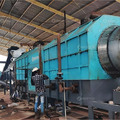As the world grapples with mounting waste management challenges and seeks sustainable solutions to address environmental concerns, waste pyrolysis has emerged as a promising technology in the United Kingdom (UK)。 This innovative process offers a means to convert various types of waste materials into valuable resources, including biofuels, chemicals, and energy. In this comprehensive exploration, we delve into the intricacies of waste pyrolysis plant UK, its applications, benefits, challenges, and the pivotal role it plays in advancing the nation's circular economy agenda.

Understanding Waste Pyrolysis:
Waste pyrolysis is a thermal decomposition process that involves heating organic materials, such as plastics, biomass, and rubber, in the absence of oxygen to produce useful products, including liquid bio-oil, syngas, and char. This process enables the conversion of non-recyclable or challenging-to-recycle waste streams into valuable commodities, thereby reducing reliance on landfilling and contributing to resource efficiency and environmental sustainability.
Applications of Waste Pyrolysis in the UK:
Waste pyrolysis holds diverse applications across various sectors in the UK, including:
Waste Management: Pyrolysis provides an alternative to traditional waste disposal methods, offering a sustainable means to manage and treat mixed or contaminated waste streams that are unsuitable for recycling.
Energy Recovery: The bio-oil and syngas produced through pyrolysis can be utilized as renewable energy sources, either through combustion for heat and power generation or further processing into biofuels for transportation.
Chemical Production: Pyrolysis-derived bio-oil contains valuable chemical compounds that can be refined into industrial chemicals, solvents, and specialty products, contributing to the UK's chemical manufacturing sector.
Circular Economy Initiatives: Waste pyrolysis aligns with the principles of the circular economy by promoting resource recovery, material reuse, and closed-loop systems, thereby reducing dependence on virgin resources and minimizing waste generation.
Benefits of Waste Pyrolysis in the UK:
The adoption of waste pyrolysis technologies offers a multitude of benefits to the UK, including:
Waste Diversion: Pyrolysis provides a sustainable alternative to landfilling for managing non-recyclable waste streams, thereby reducing the environmental burden of waste disposal and minimizing land use conflicts.
Resource Recovery: Through the conversion of waste materials into valuable products, such as biofuels and chemicals, pyrolysis enables the recovery of resources that would otherwise be lost or underutilized, contributing to resource efficiency and circularity.
Renewable Energy Production: Pyrolysis-derived bio-oil and syngas serve as renewable energy sources, offering opportunities to diversify the UK's energy mix, enhance energy security, and mitigate greenhouse gas emissions.
Economic Growth and Innovation: The development and deployment of waste pyrolysis technologies foster innovation, create new employment opportunities, and stimulate economic growth in sectors related to waste management, energy, and manufacturing.
Environmental Protection: By diverting waste from landfills and reducing reliance on fossil fuels, waste pyrolysis contributes to mitigating environmental pollution, conserving natural resources, and combating climate change.
Challenges and Considerations:
Despite its potential benefits, waste pyrolysis in the UK faces several challenges and considerations, including:
Technological Maturity: The commercial viability and scalability of waste pyrolysis technologies are contingent upon ongoing research and development efforts to optimize process efficiency, product quality, and cost-effectiveness.
Regulatory Frameworks: Effective regulatory frameworks are needed to govern the environmental, health, and safety aspects of waste pyrolysis operations, ensuring compliance with standards and addressing potential risks associated with emissions and by-products.
Market Demand and Infrastructure: The successful implementation of waste pyrolysis requires supportive market conditions, adequate infrastructure, and investment incentives to incentivize private sector participation and market uptake of pyrolysis-derived products.
Public Perception and Acceptance: Public awareness, education, and engagement are essential for fostering acceptance and trust in waste pyrolysis technologies, addressing concerns related to emissions, odors, and potential environmental impacts.
Feedstock Availability and Composition: The availability and composition of feedstock materials influence the feasibility and economics of waste pyrolysis projects, necessitating supply chain management strategies and diversification of feedstock sources.

Future Outlook and Conclusion:
Waste pyrolysis holds immense promise as a transformative technology for sustainable waste management, resource recovery, and energy production in the UK. As the nation strives to achieve its ambitious environmental targets, including zero waste goals and carbon neutrality objectives, investment in waste pyrolysis research, infrastructure, and policy support will be essential. By leveraging the potential of waste pyrolysis as a key enabler of the circular economy, the UK can pave the way towards a more resilient, resource-efficient, and environmentally sustainable future. Through collaborative efforts between government, industry, academia, and civil society, waste pyrolysis can unlock new opportunities for innovation, economic growth, and environmental stewardship, positioning the UK at the forefront of the global transition towards a circular and low-carbon economy.





